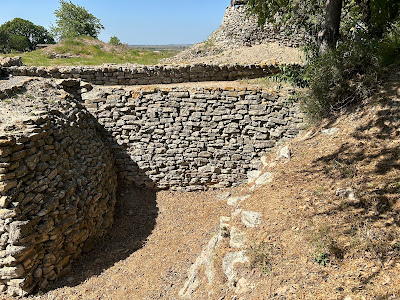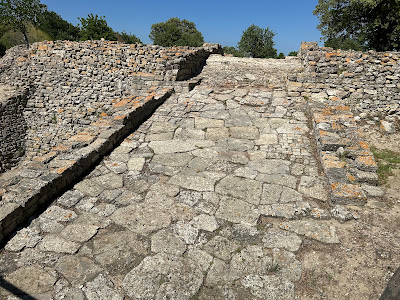 |
| Schematic of Troy (Source) |
As part of the exhibit of ruins, a portion of the citadel wall of Troy II and Troy III (2500-2000 B.C.). These are modern bricks which are built over the original mud bricks that were found. Additionally, the cover you see overhead is the same height as the initial height of the mound circa A.D. 1871.
Fortifications from Troy 1 (circa 2920 B.C.):
The Schliemann Trench: Cut in between A.D. 1871 and 1890, this is the original trench dug by Schliemann in his discovery.
Schliemann's name, celebrated in his day, is now roundly cursed by almost every archaeologist (ask me; I have one for a daughter). Schliemann just buldozed his way through, failing to denote items as they were discovered or mark differentiation in layers. In discovering the site, he destroyed a great deal of its value for future archaeologists (they now do things much differently, of course).
This is the reconstructed ramp of the Troy II citadel (2500 - 2300 B.C.) . The citadel walls this led into were 3300 meters in circumference and 4 meters thick. This version of the city was destroyed by fire, leaving ash to the depth of 2 meters.
An artist's conception of the rampa and walls in their time:














Good thing Schliemann didn't have access to modern power equipment. One item didn't change over the years, high ground eh TB?
ReplyDeleteThe mind reels, Nylon12 - Schliemann with power equipment would have been the equivalent of modern technology on the battlefields of World War I: the power of destruction magnified by modern science.
DeleteThe high ground sticks out in almost all of the sites we visited in Greece and Turkey. Defense was a great deal more important back in the old days.
So many secrets in those rocks. It sounds like there is a plan for some restoration, although I imagine it will be a slow endeavor.
ReplyDeleteLeigh, one wishes they could do the equivalent of a Mycenae restoration (which is stellar). That said, there are the factors of money (always money), focus (Turkey has a plethora of historical sites; where to develop is always a question. And Troy is a bit off the beaten path), and frankly, politics. In the Wikipedia article there was a note that in 2013 a dig was planned but Turkey pulled out at the last moment and gave it to a local Turkish university. While I understand the principle, that is the sort of thing that discourages such expeditions in favor of perhaps more established sites, but sites in countries with governments that can act less arbitrarily.
Delete